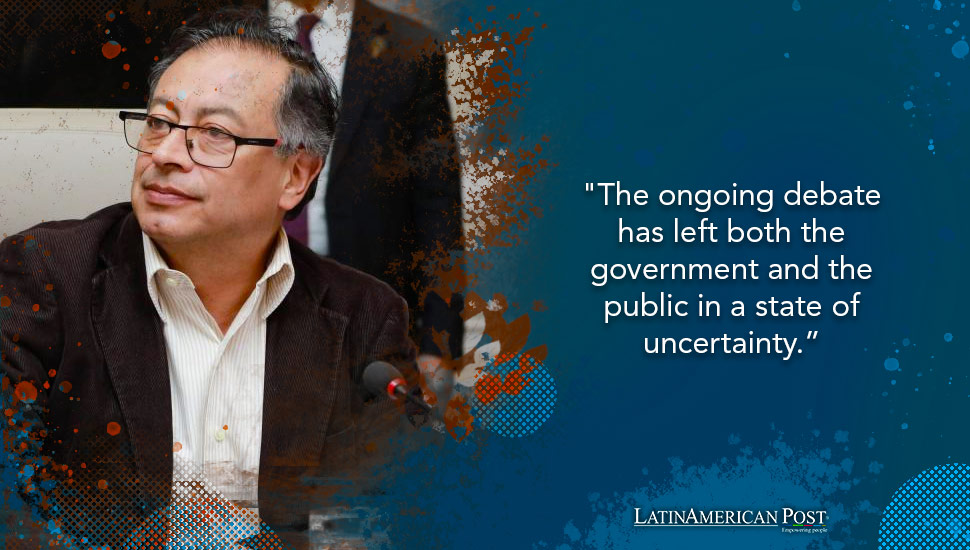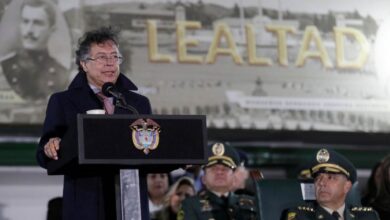Confusion Surrounds Colombian President Petro’s Push for New Constitution

President Gustavo Petro’s recent removal of Interior Minister Luis Fernando Velasco highlights the disorganization and confusion surrounding Colombia’s push for a new constitution. The ongoing debate has left both the government and the public in a state of uncertainty.
President Gustavo Petro’s sudden dismissal of Colombia’s Interior Minister, Luis Fernando Velasco, has thrown the government’s push for a new constitution into a state of confusion. Petro thanked Velasco for his “good work” and announced that the next minister would focus on establishing the necessary connections to solidify the constituent power, either in this government or the next. This move, however, has only deepened the sense of disarray and uncertainty surrounding the initiative.
Velasco, who took office in May 2023, replaced Alfonso Prada and had a short yet impactful tenure marked by significant legislative achievements and efforts toward social reform. His abrupt removal, however, raises serious questions about the coherence and direction of Petro’s administration, which seems increasingly mired in internal conflicts and a need for a clear strategy regarding the proposed new constitution.
How Velasco was removed and the subsequent communication regarding his departure has been anything but smooth. President Petro’s announcement on social media platform X (formerly Twitter) came weeks after he hinted at changes in his cabinet, creating an air of uncertainty and speculation. Velasco’s farewell message on X reflected a mix of gratitude and a veiled critique of the handling of his exit, highlighting the disarray in the transition process.
“Being part of a progressive project has marked my life, and I thank you for your trust,” Velasco wrote. He emphasized the importance of defending the project from any position he could hold, citing significant social reforms and legislative achievements during his tenure. This public exchange has left many questioning the transparency and organizational capabilities of the administration, particularly concerning the constituent assembly.
Constituent Power: A Polarizing Issue
The debate over a new constitution has been a central and contentious issue in Colombia. Petro’s frequent references to the constituent assembly have added to the confusion, suggesting a government more focused on internal power struggles than transparent governance. The lack of a clear successor for Velasco and the ambiguous future direction of the constituent process underscores the administration’s disorganization.
In his farewell, Velasco noted his accomplishments, including resolving over 1,600 conflicts with communities without violence and initiating a project for 20 safe zones with technology and artificial intelligence in collaboration with local governments. Despite these achievements, the uncertainty surrounding the constituent power debate raises concerns about the administration’s ability to follow through on its promises and maintain continuity in its policies.
A Pattern of Instability
The disorganization within Petro’s government reflects a broader trend in Latin American politics, where governments often face similar challenges of internal discord and unclear policy directions. In this context, Petro’s handling of Velasco’s removal and the constituent assembly debate can be seen as symptomatic of more significant issues within Latin American governance structures, where political instability and frequent cabinet changes are expected.
The push for a constituent assembly has been a polarizing issue, with significant public and political discourse around its implications. Petro’s comments about the need for the next Interior Minister to secure this power underlines the administration’s priorities but also expose the fragility and contentiousness of the political landscape.
As Colombia navigates these turbulent times, the need for a stable and coherent government becomes increasingly critical. The disorganized approach to cabinet changes and the lack of clear communication from the leadership only undermine the administration’s confidence. Petro’s government must address these issues head-on for it to move forward effectively.
Ensuring a smooth transition of power within the cabinet and clearly outlining the administration’s strategic priorities are essential steps. The following Interior Minister will be challenged to continue Velasco’s initiatives and foster a sense of stability and direction within the government. Transparency in decision-making and communication will be vital to rebuilding trust and maintaining public support.
Urgency for Clarity and Organization
The recent developments in Petro’s cabinet highlight the urgent need for better organization and clarity within the Colombian government, particularly regarding the constituent assembly debate. As the country faces significant social and political challenges, a cohesive and transparent administration is paramount. The disorganized handling of Velasco’s removal is a stark reminder of the work ahead for President Petro and his team.
Also read: Colombia and Sweden Strengthen Ties with New Bilateral Agreement
The administration must prioritize clear communication, strategic planning, and internal cohesion. By addressing these issues, Petro’s government can better navigate the complexities of governance and work towards achieving its social reform and constituent power goals. The administration’s stability and future success depend on its ability to learn from these missteps and create a more organized and unified approach to governance.





